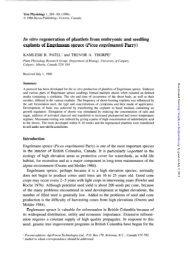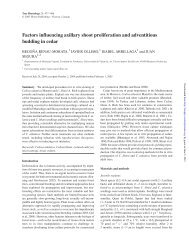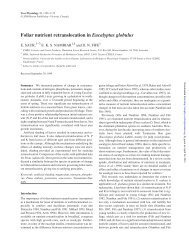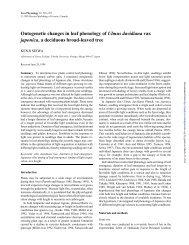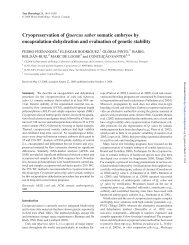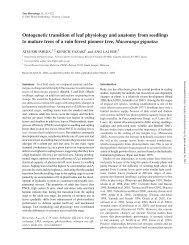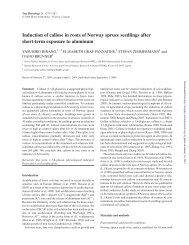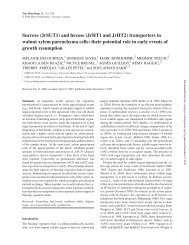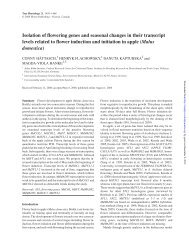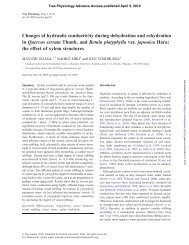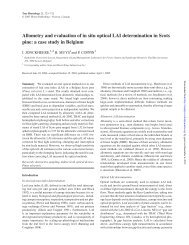Seasonal photosynthetic gas exchange and leaf ... - Tree Physiology
Seasonal photosynthetic gas exchange and leaf ... - Tree Physiology
Seasonal photosynthetic gas exchange and leaf ... - Tree Physiology
Create successful ePaper yourself
Turn your PDF publications into a flip-book with our unique Google optimized e-Paper software.
<strong>Tree</strong> <strong>Physiology</strong> 28, 1037–1048<br />
© 2008 Heron Publishing—Victoria, Canada<br />
<strong>Seasonal</strong> <strong>photosynthetic</strong> <strong>gas</strong> <strong>exchange</strong> <strong>and</strong> <strong>leaf</strong> reflectance<br />
characteristics of male <strong>and</strong> female cottonwoods in a riparian woodl<strong>and</strong><br />
MATTHEW G. LETTS, 1,2 COLLEEN A. PHELAN, 3 DAVIN R. E. JOHNSON 1 <strong>and</strong> STEWART<br />
B. ROOD 3<br />
1<br />
Department of Geography, University of Lethbridge, Lethbridge, AB T1K 3M4, Canada<br />
2<br />
Corresponding author (matthew.letts@uleth.ca)<br />
3<br />
Department of Biological Sciences, University of Lethbridge, Lethbridge, AB T1K 3M4, Canada<br />
Received September 16, 2007; accepted January 10, 2008; published online May 1, 2008<br />
Summary Cottonwoods (Populus spp.) are dioecious phreatophytes<br />
of hydrological <strong>and</strong> ecological importance in riparian<br />
woodl<strong>and</strong>s throughout the Northern Hemisphere. In<br />
streamside zones of southern Alberta, groundwater <strong>and</strong> soil<br />
water typically decline between May <strong>and</strong> September. To underst<strong>and</strong><br />
how narrow<strong>leaf</strong> cottonwoods (Populus angustifolia<br />
James) are adapted to this seasonal decrease in water availability,<br />
we measured <strong>photosynthetic</strong> <strong>gas</strong> <strong>exchange</strong>, <strong>leaf</strong> reflectance,<br />
chlorophyll fluorescence <strong>and</strong> stable carbon isotope composition<br />
(δ 13 C) in trees growing in the Oldman River valley of<br />
southern Alberta during the 2006 growth season. Accompanying<br />
the seasonal recession in river flow, groundwater table<br />
depth (Zgw) declined by 1.6 m, but neither mean daily light-saturated<br />
net <strong>photosynthetic</strong> rate (Amax) nor stomatal conductance<br />
(gs) was correlated with this change. Both Amax <strong>and</strong> gs followed<br />
a parabolic seasonal pattern, with July 24 maxima of 15.8 µmol<br />
m –2 s –1 <strong>and</strong> 559 mmol m –2 s –1 , respectively. The early summer<br />
rise in Amax was related to an increase in the chlorophyll pool<br />
during <strong>leaf</strong> development. Peak Amax coincided with the maximum<br />
quantum efficiency of Photosystem II (Fv/Fm), chlorophyll<br />
index (CI) <strong>and</strong> scaled photochemical reflectance index<br />
(sPRI), but occurred one month after maximum volumetric soil<br />
water (θv) <strong>and</strong> minimum Zgw. In late summer, Amax decreased by<br />
30–40% from maximum values, in weak correlation with θv<br />
(r 2 = 0.50). Groundwater availability limited late-season water<br />
stress, so that there was little variation in mean daily transpiration<br />
(E ). Decreasing <strong>leaf</strong> nitrogen (% dry mass), CI, Fv/Fm <strong>and</strong><br />
normalized difference vegetation index (NDVI) were also consistent<br />
with <strong>leaf</strong> aging effects. There was a strong correlation<br />
between Amax <strong>and</strong> gs (r 2 = 0.89), so that <strong>photosynthetic</strong> water-use<br />
efficiency (WUE; Amax/E) decreased logarithmically<br />
with increasing vapor pressure deficit in both males (r 2 = 0.75)<br />
<strong>and</strong> females (r 2 = 0.95). The male:female ratio was unequal<br />
(2:1, χ 2 = 16.5, P < 0.001) at the study site, but we found no significant<br />
between-sex differences in <strong>photosynthetic</strong> <strong>gas</strong> <strong>exchange</strong>,<br />
<strong>leaf</strong> reflectance or chlorophyll fluorescence that might<br />
explain the unequal ratio. Females tended to display lower<br />
NDVI than males (P = 0.07), but mean WUE did not differ significantly<br />
between males <strong>and</strong> females (2.1 ± 0.2 versus 2.5 ±<br />
0.2 mmol mol –1 ), <strong>and</strong> δ 13 C remained in the –28.8 to –29.3‰<br />
range throughout the growth season, in both sexes. These results<br />
demonstrate changes in <strong>photosynthetic</strong> <strong>and</strong> water-use<br />
characteristics that collectively enable vigorous growth<br />
throughout the season, despite seasonal changes in water supply<br />
<strong>and</strong> dem<strong>and</strong>.<br />
Keywords: chlorophyll fluorescence, photochemical reflectance<br />
index, Populus angustifolia, sexual dimorphism, stable<br />
carbon isotope.<br />
Introduction<br />
Cottonwood trees (Populus spp.) are found in riparian zones<br />
throughout continental North America <strong>and</strong> Eurasia (Naiman<br />
<strong>and</strong> Décamps 1997, Rood et al. 2003). As obligate phreatophytes,<br />
they typically obtain more than 80% of the water required<br />
for growth, development <strong>and</strong> reproduction from alluvial<br />
groundwater sources (Gazal et al. 2006). In arid <strong>and</strong><br />
semi-arid regions of western North America, where streamdependent<br />
groundwater is the only persistent water source,<br />
cottonwoods are the dominant tree species (Patten 1998).<br />
They are of great hydrological importance because of the contribution<br />
of cottonwood transpiration to riparian water flux<br />
(Goodrich et al. 2000), <strong>and</strong> they are of great ecological importance<br />
through the provision of habitat for a variety of plant <strong>and</strong><br />
animal species (Fierke <strong>and</strong> Kauffman 2006), the resistance of<br />
bank erosion (Perucca et al. 2007), the interception of nutrients<br />
<strong>and</strong> pollutants from surface <strong>and</strong> groundwater (Patten<br />
1998, Kelly et al. 2007), <strong>and</strong> the contribution of photosynthate<br />
to food-webs of riparian <strong>and</strong> aquatic ecosystems (Naiman et<br />
al. 2005).<br />
Effects of water stress on riparian cottonwoods<br />
Woody riparian plants are thought to be less physiologically<br />
adapted to drought than non-phreatophytes in otherwise arid<br />
environments (Smith et al. 1991, 1998). Cottonwoods exhibit<br />
high stomatal conductance (gs) <strong>and</strong> transpiration rates (E)under<br />
moist conditions (Chen et al. 2006), <strong>and</strong> low foliar stable<br />
Downloaded from<br />
http://treephys.oxfordjournals.org/ by guest on February 4, 2013
1038 LETTS, PHELAN, JOHNSON AND ROOD<br />
carbon isotope composition (δ 13 C), between –31 <strong>and</strong> –28‰.<br />
This suggests that persistent groundwater availability lowers<br />
<strong>photosynthetic</strong> water-use efficiency (WUE; Leffler <strong>and</strong> Evans<br />
2001). Transpiration is enhanced by the high atmospheric vapor<br />
pressure deficits (D) in arid regions (Schaeffer et al. 2000,<br />
Gazal et al. 2006), but the negative effect of high E on soil water<br />
availability is mitigated by groundwater replenishment<br />
from the adjacent losing streams. Nevertheless, a variety of<br />
physiological changes are observed in cottonwoods in response<br />
to increasing groundwater table depth (Zgw). At the <strong>leaf</strong><br />
scale, the primary physiological response to water deficit is<br />
stomatal closure, which results in lower E (Smith et al. 1991,<br />
Braatne et al. 1992, Mahoney <strong>and</strong> Rood 1992, Loewenstein<br />
<strong>and</strong> Pallardy 1998, Amlin <strong>and</strong> Rood 2002, Cooper et al. 2003),<br />
lower light-saturated net <strong>photosynthetic</strong> rate (Amax; Horton et<br />
al. 2001a, 2001b, 2001c), higher WUE (Amax/E or Amax/gs) <strong>and</strong><br />
a lower ratio between internal <strong>and</strong> atmospheric CO2 concentrations<br />
(ci/ca). Lower ci/ca leads to less negative stable carbon<br />
isotope ratios (δ 13 C) in plant tissues, including leaves<br />
(Ehleringer 1993).<br />
Leaf pigment concentration <strong>and</strong> composition are also influenced<br />
by plant water status. Water deficit tends to result in<br />
lower reflectance indices, including the normalized difference<br />
vegetation index (NDVI), chlorophyll index (CI), water b<strong>and</strong><br />
index (WBI) <strong>and</strong> photochemical reflectance index (PRI;<br />
Gamon et al. 1990). Chlorophyll fluorescence is also affected<br />
by plant water status. Dark-adapted values of the optimum<br />
quantum yield of Photosystem II (Fv/Fm) provide an indicator<br />
of <strong>photosynthetic</strong> capacity. Under optimal conditions, Fv/Fm is<br />
about 0.83 in most species (Björkman <strong>and</strong> Demmig 1987), but<br />
water stress <strong>and</strong> photoinhibition cause Fv/Fm to decrease. Photochemical<br />
efficiency of Photosystem II (ΦPSII) also responds<br />
negatively to water stress, with ΦPSII being a measure<br />
of the proportion of <strong>photosynthetic</strong> photon flux (PPF) absorbed<br />
by chlorophyll that is utilized in photochemistry.<br />
Sexual dimorphism in physiological traits<br />
Photosynthetic <strong>gas</strong> <strong>exchange</strong> characteristics <strong>and</strong> their response<br />
to drought often differ between male <strong>and</strong> female genotypes<br />
of dioecious plants (Dawson <strong>and</strong> Bliss 1989, Dawson<br />
<strong>and</strong> Ehleringer 1993, Leigh <strong>and</strong> Nicotra 2003). Females tend<br />
to exhibit decreased growth rates <strong>and</strong> survivorship compared<br />
with males in low resource environments, possibly because of<br />
higher allocation of resources to reproductive processes (Darwin<br />
1877, Putwain <strong>and</strong> Harper 1972, Dawson et al. 1990,<br />
Gehring <strong>and</strong> Linhart 1993, Gehring <strong>and</strong> Monson 1994,<br />
Braatne et al. 2007, Hultine et al. 2007). Sexual dimorphism in<br />
physiological responses to water stress varies among species.<br />
Water stress induces lower female gs in Salix arctica Pall.<br />
(Dawson <strong>and</strong> Bliss 1989), Pistacia lentiscus L. (Correia <strong>and</strong><br />
Diaz Barradas 2000) <strong>and</strong> Populus deltoides Batr. ex Marsh.<br />
var. wislizenii, the Rio Gr<strong>and</strong>e cottonwood (Rowl<strong>and</strong> 2001).<br />
This response may have evolved because of greater selection<br />
pressure favoring water conservation during the fruit maturation<br />
period (Gehring <strong>and</strong> Monson 1994). However, in other<br />
species, such as Acer negundo L. var. interior, males respond<br />
to water stress with lower gs than females (Dawson <strong>and</strong><br />
Ehleringer 1993). Similarly, higher gs results in lower female<br />
<strong>leaf</strong> water potential (Ψl)inSalix glauca L. (Dudley <strong>and</strong> Galen<br />
2007) <strong>and</strong> in lower female WUE in Maireana pyramidata<br />
(Benth.) Paul G. Wilson (Leigh <strong>and</strong> Nicotra 2003).<br />
Skewed sex ratios are often observed in cottonwood groves<br />
of western North America (Gom <strong>and</strong> Rood 1999, Braatne et al.<br />
2007). In Rio Gr<strong>and</strong>e cottonwood groves of New Mexico, the<br />
highest male:female ratios are found in the driest riparian environments<br />
(Rowl<strong>and</strong> <strong>and</strong> Johnson 2001). In a common garden<br />
study of the same species, gs varied significantly with reproductive<br />
status <strong>and</strong> sex (Rowl<strong>and</strong> 2001). Non-reproductive<br />
specimens had the highest gs, followed by males <strong>and</strong> then females,<br />
but no significant differences were observed in Amax.<br />
Given the relevance of dioecy to both carbon <strong>and</strong> water cycling<br />
in riparian ecosystems (Hultine et al. 2007), it is important to<br />
categorize dioecious species on the basis of sex when evaluating<br />
the effects of environmental stress on <strong>photosynthetic</strong> productivity<br />
<strong>and</strong> water-use efficiency.<br />
We measured <strong>photosynthetic</strong> <strong>gas</strong> <strong>exchange</strong>, <strong>leaf</strong> reflectance,<br />
chlorophyll fluorescence <strong>and</strong> δ 13 C ratio during the growth period<br />
of 2006, in male <strong>and</strong> female genotypes of Populus<br />
angustifolia James, the narrow<strong>leaf</strong> cottonwood. We tested<br />
three hypotheses related to plant water use: (1) seasonal<br />
groundwater <strong>and</strong> soil water depletion result in higher WUE<br />
(Amax/gs), lower reflectance indices (PRI, NDVI, CI <strong>and</strong> WBI)<br />
<strong>and</strong> less negative δ 13 C; (2) E, gs <strong>and</strong> Amax increase in response<br />
to irrigation of soils with low water content in the vadose zone;<br />
<strong>and</strong> (3) females exhibit less negative δ 13 C, lower gs <strong>and</strong> higher<br />
WUE than males in response to water stress.<br />
Materials <strong>and</strong> methods<br />
TREE PHYSIOLOGY VOLUME 28, 2008<br />
Site description<br />
The study was carried out at Pearce Corner Cottonwood Grove<br />
(PCCG; 49°51′03″ N, 113°15′18″ W), a 3-ha woodl<strong>and</strong>, east<br />
of Fort MacLeod, AB, Canada. The PCCG floodplain is located<br />
on the south side of the Oldman River, along a constrained,<br />
200–250-m-wide reach. Within the 430 × 70 m<br />
woodl<strong>and</strong>, located 50 to 120 m inl<strong>and</strong> from the riverbank,<br />
st<strong>and</strong> density is 205 stems ha –1 (Willms et al. 2006). <strong>Tree</strong>s in<br />
the grove rely on groundwater that is largely supplied by the<br />
Oldman River. Stream flow at PCCG is reduced upstream by<br />
diversion at the Lethbridge Northern Irrigation District<br />
(LNID) weir, which was installed in 1925. The Oldman River<br />
Dam, completed in 1993, traps water from high spring flows<br />
for release in summer, to restore natural seasonal flow patterns<br />
(Rood et al. 2005). Mean August <strong>and</strong> September stream flow<br />
was reduced from 25.2 to 12.7 m 3 s –1 following construction<br />
of the LNID weir, but has been restored to a mean of 23.2 m 3<br />
s –1 since 1993. In addition to cottonwoods, willows (Salix<br />
spp.), especially the s<strong>and</strong>bar willow (Salix exigua Nutt.), occur<br />
at the site, <strong>and</strong> grow in highest density near the edge of the<br />
river, where soil water content is higher <strong>and</strong> flooding is most<br />
frequent. The cottonwood understory consists of a diverse set<br />
of tall C3 grasses <strong>and</strong> herbaceous dicotyledons. Mean annual<br />
Downloaded from<br />
http://treephys.oxfordjournals.org/ by guest on February 4, 2013
PHOTOSYNTHETIC GAS EXCHANGE IN NARROWLEAF COTTONWOODS 1039<br />
precipitation is 425 mm, with 61% typically occurring during<br />
the May to September period covered by this study. Mean annual<br />
temperature is 5.7 °C at Fort Macleod, with mean<br />
monthly temperature peaking at 18.0 °C in July (Environment<br />
Canada 2005).<br />
Monitoring of environmental conditions<br />
Environmental variables were measured from day of year<br />
(DOY) 120 to 270 with a Dynamet weather station<br />
(Dynamax, Houston, TX) located in a clear area, 60 m to the<br />
WNW of the trees. Air temperature (Tair) <strong>and</strong> relative humidity<br />
(RH) at a height of 1.2 m were measured with a CS500 temperature<br />
<strong>and</strong> relative humidity probe (Campbell Scientific, Logan,<br />
UT). Precipitation was measured with a tipping bucket<br />
rain gauge (TE525, Campbell Scientific). Volumetric soil water<br />
(θv) was measured at 0.2-, 0.5- <strong>and</strong> 0.8-m depths with<br />
ThetaProbe ML2x sensors <strong>and</strong> recorded with a THLog-4 data<br />
logger (Dynamax). A silicon radiation sensor (LI-200SZ,<br />
Li-Cor, Lincoln, NE) was used to measure solar insolation<br />
(K ). Measurements were taken at hourly intervals, except for<br />
θv, which was determined at a 4-h interval. Depth to the saturated<br />
water table within the cluster of eight study trees was determined<br />
at two open wells consisting of steel pipes attached to<br />
stainless steel well points with mesh screens (Model 615N,<br />
Solinst Canada), driven 3.8 m into the riparian substrate. Water<br />
table depths were determined at weekly intervals with an electric<br />
water level meter (Model 101, Solinst Canada).<br />
Photosynthetic <strong>gas</strong> <strong>exchange</strong> measurements<br />
Eight Populus angustifolia trees, four male <strong>and</strong> four female,<br />
were selected for study within a 250 m 2 area of the floodplain<br />
60 to 80 m inl<strong>and</strong> from the riverbank, to ensure the study trees<br />
were growing under similar hydrological conditions. The trees<br />
were selected on the basis of species analysis, apparent health<br />
<strong>and</strong> proximity to soil water sensors as well as for similarity in<br />
depth to water table, age, height <strong>and</strong> tree architecture. Species<br />
analysis was performed by measuring <strong>leaf</strong> blade <strong>and</strong> petiole<br />
shape (Rood et al. 1986), to avoid selecting trees strongly hybridized<br />
with P. balsamifera L. ssp. trichocarpa. Reproductive<br />
bud flush stage was recorded from DOY 130 to 135, to ensure<br />
that clones were not chosen as study trees.<br />
Photosynthetic <strong>gas</strong> <strong>exchange</strong> was measured on DOY 136,<br />
172, 191, 205, 220, 237 <strong>and</strong> 247 with a portable TPS-1 Photosynthesis<br />
System equipped with a 25 × 18 mm PLC6 automatic<br />
universal <strong>leaf</strong> cuvette (PP Systems, Amesbury, MA),<br />
calibrated by the manufacturer in April 2006. Gas <strong>exchange</strong><br />
characteristics were determined in full sun (<strong>photosynthetic</strong><br />
photon flux exceeding 1000 µmol m –2 s –1 ) on three sun-exposed<br />
leaves of the lower canopy (2–5 m above ground) of<br />
each tree, between 1100 <strong>and</strong> 1600 h. The three leaves chosen<br />
from each tree were each from a branch of different aspect (N,<br />
SE or SW). Ten <strong>gas</strong> <strong>exchange</strong> measurements were made to obtain<br />
a mean value for each <strong>leaf</strong>, <strong>and</strong> the three <strong>leaf</strong> values were<br />
averaged to obtain the mean for each tree. For each measurement<br />
date, mean values for each sex were derived from the<br />
four tree means. The mean (± st<strong>and</strong>ard error) chamber CO2<br />
concentration for the ten measurement dates was 386.7 ±<br />
1.8 ppm, with no seasonal trend. Time of day effects were minimized<br />
by switching between male <strong>and</strong> female trees at least<br />
once for every six leaves sampled. Cloudiness occasionally reduced<br />
the number of leaves sampled on certain trees, <strong>and</strong> the<br />
number of trees was reduced from 8 to 4 on DOY 237, because<br />
measurements were taken on both green <strong>and</strong> precociously senescent<br />
leaves. For the seven measurement dates, the total<br />
numbers of male <strong>and</strong> female leaves (measurements) were<br />
75 (801) <strong>and</strong> 68 (712), respectively. Following <strong>leaf</strong> collection,<br />
<strong>leaf</strong> area was determined with a Li-Cor LI-3100C <strong>leaf</strong> area<br />
meter. Leaves were then dried for 48 h at 70 °C <strong>and</strong> weighed.<br />
Specific <strong>leaf</strong> area (SLA) was calculated by dividing projected<br />
<strong>leaf</strong> area by <strong>leaf</strong> dry mass.<br />
Leaf reflectance<br />
Adaxial <strong>leaf</strong> reflectance was measured on three leaves (SW,<br />
SE <strong>and</strong> N aspect) of each study tree on six dates (DOY 172,<br />
191, 205, 220, 237 <strong>and</strong> 247), with a field spectroradiometer<br />
(Unispec-SC Spectral Analysis System, PP Systems),<br />
equipped with a bifurcated fiber optic cable (UNI400) <strong>and</strong> <strong>leaf</strong><br />
clip (UNI500). The spectral range was 400 to 1000 nm <strong>and</strong> the<br />
resolution was 10 nm. To account for instrument noise effects,<br />
dark scans preceded all measurements. Leaf reflectance was<br />
calculated by dividing <strong>leaf</strong> radiance by the irradiance of a<br />
99%-reflective polytetrafluoroethylene (PTFE) calibration<br />
disk (UNI420). Reflectance from this disk was measured before<br />
each measurement, as a white reference. The mean of ten<br />
scans was used to obtain the spectral response curve for each<br />
<strong>leaf</strong>. Based on 1-nm b<strong>and</strong>widths interpolated from the<br />
spectroradiometer data, PRI (Gamon et al. 1997), NDVI<br />
(Tucker 1979), CI (Gitelson <strong>and</strong> Merzlyak 1994) <strong>and</strong> WBI<br />
(Peñuelas et al. 1997) were determined as:<br />
R − R<br />
PRI =<br />
R + R<br />
531 570<br />
531 570<br />
R − R<br />
NDVI =<br />
R + R<br />
R − R<br />
CI =<br />
R + R<br />
WBI = R<br />
R<br />
800 670<br />
800 670<br />
750 705<br />
750 705<br />
900<br />
970<br />
where R is reflectance <strong>and</strong> subscripts refer to wavelengths in<br />
nm. To avoid negative values of PRI, we report the scaled<br />
value of PRI (sPRI):<br />
PRI +1<br />
sPRI =<br />
2<br />
TREE PHYSIOLOGY ONLINE at http://heronpublishing.com<br />
Chlorophyll fluorescence<br />
On DOY 172, 191, 205, 220 <strong>and</strong> 237, chlorophyll fluorescence<br />
(1)<br />
(2)<br />
(3)<br />
(4)<br />
(5)<br />
Downloaded from<br />
http://treephys.oxfordjournals.org/ by guest on February 4, 2013
1040 LETTS, PHELAN, JOHNSON AND ROOD<br />
measurements (Fv/Fm <strong>and</strong> ΦPSII) were made on the same<br />
leaves sampled for <strong>leaf</strong> reflectance, with an FMS2 pulse modulated<br />
chlorophyll fluorimeter (Hansatech Instruments, U.K.).<br />
Before Fv/Fm was determined, all leaves were dark adapted for<br />
a minimum of 30 min, using the <strong>leaf</strong> clip. About 30 s after<br />
measuring Fv/Fm, ΦPSII was determined on the same <strong>leaf</strong> tissue<br />
in full natural sunlight, rather than with the actinic light<br />
source.<br />
Stable carbon isotope composition<br />
A selection of dried leaves gathered on DOY 172, 205 <strong>and</strong> 237<br />
were chosen for N <strong>and</strong> δ 13 C analyses. Individual <strong>leaf</strong> samples<br />
were immersed in liquid nitrogen <strong>and</strong> crushed with a mortar<br />
<strong>and</strong> pestle. To determine stable carbon isotope composition<br />
<strong>and</strong> total N concentration (%), tissue samples (about 5 mg)<br />
were weighed into tin cups, <strong>and</strong> combusted in an elemental analyzer<br />
(NC2100, CE Instruments, ThermoQuest Italia, Milan,<br />
Italy), coupled to a <strong>gas</strong> isotope ratio mass spectrometer (Optima,VG<br />
Isotech, Cheshire, U.K.) operating in continuous<br />
flow mode. The δ 13 C was determined from the ratio, R<br />
( 13 CO2/ 12 CO2):<br />
δ 13<br />
C(‰) = ⎛ R<br />
⎜<br />
⎝ R<br />
sample<br />
std<br />
⎞<br />
⎟ 1000<br />
⎠<br />
where Rstd refers to the molar ratio of the international Pee Dee<br />
Belemnite st<strong>and</strong>ard.<br />
Photosynthetic water-use efficiency<br />
Photosynthetic water-use efficiency was calculated from both<br />
<strong>gas</strong> <strong>exchange</strong> measurements <strong>and</strong> from the δ 13 C composition of<br />
plant tissue. The former is an instantaneous measure of WUE,<br />
<strong>and</strong> was determined as:<br />
⎛ ci<br />
⎞<br />
ca<br />
⎜1<br />
− ⎟<br />
A ⎝ ca<br />
⎠<br />
WUE = =<br />
E 16 . v<br />
where 1.6 is the ratio of the diffusion coefficients of H2O <strong>and</strong><br />
CO2 <strong>and</strong> v is related to the difference between intracellular <strong>and</strong><br />
atmospheric H2O vapor concentrations (ei – ea; kPa) <strong>and</strong> atmospheric<br />
pressure, P (kPa) as:<br />
e − e<br />
v =<br />
P<br />
i a<br />
The stable carbon isotope composition of <strong>leaf</strong> tissue, δ 13 Cp,<br />
can be used to determine an integrated measure of WUE. The<br />
stable carbon isotope composition of <strong>leaf</strong> material is related to<br />
that of the source atmospheric CO2 (δ 13 Ca) <strong>and</strong> to ci/ca<br />
(Farquhar et al. 1982, 1989):<br />
(6)<br />
(7)<br />
(8)<br />
13 13<br />
δ C δ C a b a ci<br />
p = a − −( − ) (9)<br />
c<br />
a<br />
where δ 13 Ca is assumed to be –8‰, a is the discrimination during<br />
diffusion of CO2 in air (4.4‰), b is net discrimination during<br />
carboxylation (27.0‰) <strong>and</strong> ca is 380 µmol mol –1 , the mean<br />
CO2 concentration in July 2006 at Mauna Loa, Hawaii (Tans<br />
2007). We derived WUE from Equations 7 <strong>and</strong> 9 as (Ponton et<br />
al. 2006):<br />
13 13 ⎛ δ Cp − δ Ca + a⎞<br />
ca − ca⎜<br />
⎟<br />
A ⎝ a − b ⎠<br />
WUE = =<br />
E<br />
16 . v<br />
(10)<br />
Irrigation treatment<br />
To examine the effect of soil water availability on <strong>photosynthetic</strong><br />
<strong>gas</strong> <strong>exchange</strong> characteristics of male <strong>and</strong> female cottonwoods,<br />
45,000 l of water was pumped from the Oldman<br />
River to the base of two female <strong>and</strong> two male trees on DOY<br />
241. When irrigation was complete, the four trees were surrounded<br />
by st<strong>and</strong>ing water extending at least 4 m from the base<br />
of the trunk. On DOY 247, <strong>photosynthetic</strong> <strong>gas</strong> <strong>exchange</strong> <strong>and</strong><br />
<strong>leaf</strong> reflectance measurements were taken on three leaves of<br />
each of the four irrigated <strong>and</strong> four non-irrigated trees.<br />
Statistical analysis of physiological data<br />
Between-sex differences in <strong>leaf</strong> <strong>photosynthetic</strong> <strong>gas</strong> <strong>exchange</strong>,<br />
reflectance <strong>and</strong> fluorescence characteristics were assessed by<br />
mixed model repeated measures analysis of variance<br />
(ANOVA), with DOY as the repeated measure, sex as a fixed<br />
effect, tree identity as a r<strong>and</strong>om effect, sex × DOY interaction<br />
<strong>and</strong> post hoc evaluation by Tukey’s HSD test. Repeated measures<br />
ANOVA was also used to assess seasonal differences in<br />
<strong>photosynthetic</strong> <strong>gas</strong> <strong>exchange</strong>, foliar δ 13 C composition <strong>and</strong> Ψl<br />
(Phelan 2007). One-tailed Student’s t-tests were used to test<br />
two hypotheses: (1) females have significantly more conservative<br />
water use indicators than males, based on stable carbon<br />
isotope composition (higher δ 13 C <strong>and</strong> WUE, but lower ci/ca);<br />
<strong>and</strong> (2) irrigated trees have higher <strong>gas</strong> <strong>exchange</strong> rates <strong>and</strong><br />
lower WUE (Amax/E <strong>and</strong> Amax/gs) than non-irrigated trees.<br />
Results<br />
Environmental conditions<br />
TREE PHYSIOLOGY VOLUME 28, 2008<br />
Total precipitation at PCCG was 178.8 mm during DOY 121–<br />
247 (Table 1), with 76% occurring between DOY 146 <strong>and</strong> 171,<br />
<strong>and</strong> 48% occurring in a single event on DOY 165–166. Thereafter,<br />
rainfall was light, with all daily rainfall totals below<br />
8 mm. In response to this rainfall pattern <strong>and</strong> variation in water<br />
table depth, θv at 0.8-m depth was high in late June <strong>and</strong> early<br />
July, but decreased continuously from a peak of 0.40 m 3 m –3<br />
on DOY 170 through the months of July <strong>and</strong> August. Groundwater<br />
depth fell from –0.73 to –2.34 m from DOY 170 to 247.<br />
Total rainfall at PCCG was 23.5% below the 30-year mean for<br />
Fort Macleod during the study period (Table 1; Environment<br />
Canada 2005).<br />
Daily maximum air temperature <strong>and</strong> vapor pressure deficit<br />
were higher in July, August <strong>and</strong> early September than in May<br />
Downloaded from<br />
http://treephys.oxfordjournals.org/ by guest on February 4, 2013
<strong>and</strong> June (Table 1). Mean Tmax was 25.1 °C at PCCG, which is<br />
3.1 °C higher than the 30-year mean at Fort Macleod. Elevated<br />
temperature may, in part, be caused by the sheltered microclimate<br />
of the cottonwood grove <strong>and</strong> the Oldman River valley,<br />
but Tmax was also above average regionally. At Lethbridge Airport,<br />
55 km to the southeast, Tmax was 1.6 °C higher than the<br />
1971–2000 mean from May to August 2006 (Environment<br />
Canada 2005).<br />
Structural traits of P. angustifolia trees at PCCG<br />
Mean age of the study trees was 36.3 ± 1.7 years. Mean tree<br />
height <strong>and</strong> trunk diameter at breast height (DBH) were 11.1 ±<br />
0.7 m <strong>and</strong> 24.8 ± 1.5 cm, respectively. No gross structural differences<br />
were observed between the male <strong>and</strong> female cottonwoods<br />
sampled (Table 2), but the sex structure of cottonwoods<br />
at PCCG was imbalanced, with a male:female ratio of 2:1 that<br />
was significantly different from the expected 1:1 ratio (n =<br />
140, χ 2 = 16.5, P < 0.001). Specific <strong>leaf</strong> area (SLA) decreased<br />
from 141.2 ± 3.9 cm 2 g –1 on DOY 136 to 95.61 ± 3.2 cm 2 g –1<br />
on DOY 205. Thereafter, in fully developed leaves, SLA decreased<br />
more slowly, reaching 79.7 ± 3.0 cm 2 g –1 by DOY 247.<br />
<strong>Seasonal</strong> patterns of <strong>photosynthetic</strong> <strong>gas</strong> <strong>exchange</strong><br />
characteristics<br />
PHOTOSYNTHETIC GAS EXCHANGE IN NARROWLEAF COTTONWOODS 1041<br />
Table 1. Mean daily maximum air temperature (Tmax), maximum vapor pressure deficit (Dmax), maximum irradiance (K↓max), soil water at a depth<br />
of 0.8 m (θv), groundwater table depth (Zgw) <strong>and</strong> total precipitation at the Pearce Corner Cottonwood Grove, during <strong>and</strong> preceding the study period<br />
(day of year (DOY) 121–247). Values of Tmax, Dmax <strong>and</strong> K↓max were calculated from peak hourly values for each day. Errors shown are st<strong>and</strong>ard<br />
deviations. Abbreviation: ND = no data.<br />
Month (DOY) Tmax (°C) Dmax (kPa) K↓max(W m –2 ) θv (m 3 m –3 ) Zgw (cm) Precipitation (mm)<br />
May (121–151) 21.1 ± 7.0 2.0 ± 1.1 810 ± 154 ND –121.5 25.4<br />
June (152–181) 23.3 ± 4.5 1.8 ± 0.9 783 ± 233 0.24 –108.9 113.8<br />
July (182–212) 30.2 ± 3.1 3.0 ± 0.8 864 ± 102 0.22 –203.1 4.3<br />
August (213–243) 28.5 ± 3.8 3.0 ± 0.9 770 ± 109 0.15 –228.1 35.3<br />
September (244–247) 26.6 ± 6.9 2.9 ± 1.4 765 ± 26 0.12 –233.1 0.0<br />
Mean daily light-saturated <strong>photosynthetic</strong> rate increased during<br />
the late spring <strong>and</strong> early summer to a maximum near<br />
15.8 µmol m –2 s –1 on DOY 205 (Figure 1). For the remainder<br />
of the season, mean Amax ranged from 10.0 to 10.3 µmol m –2<br />
s –1 . With data from males <strong>and</strong> females pooled, Amax exhibited a<br />
Table 2. Characteristics of the trees <strong>and</strong> leaves studied, including age,<br />
height, diameter at breast height (DBH), peak season specific <strong>leaf</strong><br />
area (SLA; day of year (DOY) 205) <strong>and</strong> area-based <strong>leaf</strong> nitrogen content<br />
(DOY 205). Errors shown are st<strong>and</strong>ard errors. Sample sizes are<br />
shown in parentheses.<br />
Characteristic Male Female<br />
<strong>Tree</strong> age (year) 38.0 ± 2.1 (4) 34.5 ± 4.2 (4)<br />
Plant height (m) 10.7 ± 1.4 (4) 11.5 ± 1.4 (4)<br />
DBH (cm) 23.7 ± 1.3 (4) 25.9 ± 4.1 (4)<br />
SLA (cm 2 g –1 ) 82.9 ± 1.6 (18) 90.0 ± 2.7 (18)<br />
Leaf N (g m –2 ) 2.40 ± 0.11 (10) 2.35 ± 0.10 (10)<br />
TREE PHYSIOLOGY ONLINE at http://heronpublishing.com<br />
positive correlation with mean daily gs (logarithmic,<br />
r 2 = 0.89). Stomatal conductance reached a peak of 559 mmol<br />
m –2 s –1 on DOY 205, but fell to 246 mmol m –2 s –1 by DOY<br />
237. As θv declined, stomatal closure caused only a slight decrease<br />
in ci/ca, from a maximum of 0.79 at peak season to a<br />
minimum of 0.73 by DOY 237. Mean daily E remained within<br />
the 5.0 to 6.1 mmol m –2 s –1 range, except on DOY 237, when it<br />
fell to 3.3 mmol m –2 s –1 . This was the only date characterized<br />
by both low θv <strong>and</strong> low D. Water-use efficiency (Amax/E)<br />
ranged from 1.6 to 3.7 mmol mol –1 in response to variable atmospheric<br />
conditions, whereas WUE (Amax/gs) ranged from<br />
0.32 to 0.46 mmol mol –1 , with the lowest values occurring<br />
near mid-season (DOY 172–205).<br />
All <strong>photosynthetic</strong> <strong>gas</strong> <strong>exchange</strong> variables showed significant<br />
variation with DOY (P < 0.001), but no clear seasonal<br />
trend was observed in foliar δ 13 C composition, which ranged<br />
from –29.3 to –28.8‰ between DOY 172 <strong>and</strong> 237 (P = 0.93;<br />
Table 3). Using δ 13 C <strong>and</strong> D to determine ci/ca, no significant<br />
seasonal variation was observed, with values ranging from<br />
0.75 to 0.78. Values of WUE (A/E from δ 13 C) varied from<br />
2.1 to 2.8 mmol mol –1 , with significantly lower values observed<br />
on DOY 205 (P = 0.001; Table 3), because of a combi-<br />
Table 3. Water-use indicators of leaves of male <strong>and</strong> female narrow<strong>leaf</strong><br />
cottonwoods at PCCG. The ratio of internal to atmospheric CO2 concentrations<br />
(ci/ca) <strong>and</strong> water-use efficiency (WUE; mmol CO2 mol –1<br />
H2O) were calculated from Equations 9 <strong>and</strong> 10. The total numbers of<br />
trees (leaves) analyzed for stable carbon isotope ratio (δ 13 C, ‰) were<br />
6(15), 8(20) <strong>and</strong> 4(12) on day of the year (DOY) 172, 205 <strong>and</strong> 237,<br />
respectively. Mean values shown were calculated as the average of<br />
tree means. Abbreviation: SE = st<strong>and</strong>ard error.<br />
DOY Water-use Mean ± SE t P<br />
indicator<br />
Male Female<br />
172 δ 13 C –28.91 ± 0.74 –28.96 ± 0.54 0.05 0.48<br />
ci/ca 0.76 ± 0.03 0.76 ± 0.03 0.05 0.48<br />
WUE 2.60 ± 0.32 2.70 ± 0.24 0.23 0.41<br />
205 δ 13 C –29.17 ± 0.28 –28.97 ± 0.21 0.58 0.29<br />
ci/ca 0.77 ± 0.01 0.75 ± 0.01 0.58 0.29<br />
WUE 2.17 ± 0.10 2.36 ± 0.08 0.84 0.22<br />
237 δ 13 C –29.09 ± 0.48 –29.33 ± 0.10 – –<br />
ci/ca 0.77 ± 0.02 0.78 ± 0.00 – –<br />
WUE 2.64 ± 0.22 2.74 ± 0.05 – –<br />
Downloaded from<br />
http://treephys.oxfordjournals.org/ by guest on February 4, 2013
1042 LETTS, PHELAN, JOHNSON AND ROOD<br />
nation of higher D <strong>and</strong> slightly more negative δ 13 C. No significant<br />
differences were found between males <strong>and</strong> females in<br />
δ 13 C, ci/ca or WUE (Table 3).<br />
Mean daily Amax <strong>and</strong> gs were both positively correlated with<br />
θv, but negatively correlated with D (Figure 2). The relationship<br />
between gs <strong>and</strong> D was much stronger with the DOY 237<br />
data removed (r 2 = 0.81). The Zgw was poorly correlated with<br />
Amax (r 2 = 0.00), gs (r 2 = 0.03) <strong>and</strong> E (r 2 = 0.00; not shown).<br />
Transpiration rate was poorly correlated with θv (r 2 = 0.08) <strong>and</strong><br />
D (r 2 = 0.09). Because of the strong relationship between Amax<br />
<strong>and</strong> gs, <strong>and</strong> the relative invariability of E, mean daily WUE<br />
(Amax/E) was negatively <strong>and</strong> logarithmically correlated with D<br />
(Figure 2), but poorly correlated with θv (linear, r 2 = 0.12). By<br />
contrast, WUE (Amax/gs) was correlated with θv (Figure 2), but<br />
not with D (r 2 = 0.14).<br />
Chlorophyll fluorescence <strong>and</strong> <strong>leaf</strong> reflectance<br />
Mean Fv/Fm followed a parabolic seasonal pattern, with a<br />
maximum of 0.85 on DOY 191 <strong>and</strong> 205 (Figure 3). Mean<br />
TREE PHYSIOLOGY VOLUME 28, 2008<br />
Figure 1. Photosynthetic <strong>gas</strong> <strong>exchange</strong> characteristics<br />
as a function of day of year (DOY) in<br />
leaves of male (�) <strong>and</strong> female (�) narrow<strong>leaf</strong><br />
cottonwoods. Error bars denote the st<strong>and</strong>ard<br />
error of the mean. Definitions: T<strong>leaf</strong>, <strong>leaf</strong> temperature;<br />
Amax, light-saturated net <strong>photosynthetic</strong><br />
rate; Amax/gs <strong>and</strong> Amax/E, water-use<br />
efficiencies; gs, stomatal conductance; D, vapor<br />
pressure deficit; ci/ca, ratio between internal<br />
<strong>and</strong> atmospheric CO2 concentrations.<br />
ΦPSII peaked near 0.66 on DOY 191, <strong>and</strong> then decreased to<br />
0.30 by DOY 237. The NDVI exhibited a slight downward<br />
trend with DOY (Figure 3) in both males (r 2 = 0.63) <strong>and</strong> females<br />
(r 2 = 0.89), with mean daily NDVI falling from 0.874 on<br />
DOY 172 to 0.849 by DOY 237. The decline in NDVI was coincident<br />
with decreases in <strong>leaf</strong> N concentration, which fell<br />
from 2.20 ± 0.19% to 1.68 ± 0.19% on a mass basis <strong>and</strong> from<br />
2.20 ± 0.18 g m –2 to 2.13 ± 0.25 g m –2 on an area basis from<br />
DOY 172 to 237. Both CI <strong>and</strong> sPRI decreased after reaching<br />
maxima on DOY 191 <strong>and</strong> 205, respectively. The late-summer<br />
decrease in CI was proportionally larger than the decrease in<br />
NDVI.<br />
When photosynthesis <strong>and</strong> reflectance measurements were<br />
taken on the same <strong>leaf</strong> tissue (DOY 237), CI was weakly correlated<br />
with Amax (Figure 4). Net light-saturated <strong>photosynthetic</strong><br />
rates increased exponentially with sPRI, <strong>and</strong> the correlation<br />
was similar in males (r 2 = 0.54) <strong>and</strong> females (r 2 = 0.48). Values<br />
of Amax were highly variable for NDVI above 0.79, but were<br />
near zero below this threshold.<br />
Downloaded from<br />
http://treephys.oxfordjournals.org/ by guest on February 4, 2013
PHOTOSYNTHETIC GAS EXCHANGE IN NARROWLEAF COTTONWOODS 1043<br />
Response of water-stressed cottonwoods to irrigation<br />
On DOY 247, six days after irrigation of four of the eight cottonwoods,<br />
Amax, gs, E <strong>and</strong> ci/ca did not differ significantly between<br />
the irrigated <strong>and</strong> non-irrigated trees (P > 0.10; Table 4).<br />
However, large increases in gs <strong>and</strong> E were observed in individual<br />
trees, <strong>and</strong> these increases were consistent with higher sap<br />
flow rates following the irrigation treatment (Phelan 2007).<br />
Water-use efficiency measures (Amax/E <strong>and</strong> Amax/gs) were not<br />
significantly affected by the irrigation treatment. The irrigation<br />
treatment had no significant effects on the <strong>leaf</strong> reflectance<br />
indices NDVI, CI, sPRI <strong>and</strong> WBI (Table 4).<br />
Water-use efficiency of male <strong>and</strong> female cottonwoods<br />
With the exception of NDVI, which was lower in females than<br />
in males (Table 5), no significant differences were observed<br />
between the <strong>photosynthetic</strong> <strong>gas</strong> <strong>exchange</strong>, <strong>leaf</strong> reflectance,<br />
chlorophyll fluorescence or stable carbon isotope characteristics<br />
of male <strong>and</strong> female cottonwoods. No interaction was observed<br />
between sex <strong>and</strong> DOY, with the exception of sPRI,<br />
which reached a higher mid-season peak in males than in females.<br />
Discussion<br />
TREE PHYSIOLOGY ONLINE at http://heronpublishing.com<br />
Figure 2. Effects of volumetric soil water<br />
content (θv) <strong>and</strong> vapor pressure deficit (D)<br />
on light-saturated net <strong>photosynthetic</strong> rate<br />
(Amax), stomatal conductance (gs) <strong>and</strong> water-use<br />
efficiencies (Amax/gs <strong>and</strong> Amax/E) in<br />
male (�) <strong>and</strong> female (�) narrow<strong>leaf</strong> cottonwoods.<br />
Values are daily means for all<br />
dates for which both <strong>photosynthetic</strong> <strong>gas</strong><br />
<strong>exchange</strong> <strong>and</strong> θv at 0.8-m depth were<br />
available.<br />
Controls on <strong>photosynthetic</strong> <strong>gas</strong> <strong>exchange</strong> in cottonwoods<br />
Net <strong>photosynthetic</strong> rates of male <strong>and</strong> female cottonwoods followed<br />
a parabolic seasonal pattern, with strongly positive Amax<br />
values (above 10 µmol m –2 s –1 ) maintained throughout the late<br />
summer drought (Figure 1). During spring, increasing Amax<br />
was the result of a gradual increase in <strong>photosynthetic</strong> capacity.<br />
The rapid decline in SLA indicates that leaves thickened considerably<br />
during <strong>leaf</strong> expansion <strong>and</strong> development, <strong>and</strong> the increase<br />
in CI shows that the chlorophyll pool reached a maximum<br />
near DOY 191–205. Peak values of Fv/Fm, ΦPSII, sPRI<br />
<strong>and</strong> WBI also occurred at this time (Figure 3), indicating that<br />
leaves were not experiencing water stress, despite a substantial<br />
drop in θv from its peak near DOY 170. These results are consistent<br />
with those of Noormets et al. (2001), who reported substantial<br />
increases in the Rubisco content of Populus<br />
tremuloides Michx. (trembling aspen) leaves during <strong>leaf</strong> development<br />
<strong>and</strong> of Niinemets et al. (2004), who reported rapid<br />
increases in the capacity for <strong>photosynthetic</strong> electron transport<br />
(Jmax) during the first 30 days following bud burst in<br />
Downloaded from<br />
http://treephys.oxfordjournals.org/ by guest on February 4, 2013
1044 LETTS, PHELAN, JOHNSON AND ROOD<br />
Populus tremula L. Following a period of high productivity in<br />
July, Amax fell by 30–40%, in a tight, logarithmic relationship<br />
with gs. Although Amax was unrelated to Zgw, it was weakly correlated<br />
with θv (r 2 = 0.50; Figure 2).<br />
TREE PHYSIOLOGY VOLUME 28, 2008<br />
Figure 3. Chlorophyll fluorescence <strong>and</strong> <strong>leaf</strong><br />
reflectance characteristics as a function of day<br />
of year (DOY) in leaves of male (�) <strong>and</strong> female<br />
(�) narrow<strong>leaf</strong> cottonwoods. Abbreviations:<br />
quantum yield of Photosystem II, Fv/Fm;<br />
photochemical efficiency, ΦPSII; scaled value<br />
of the photochemical reflectance index, sPRI;<br />
water b<strong>and</strong> index, WBI; chlorophyll index, CI;<br />
<strong>and</strong> normalized difference vegetation index,<br />
NDVI.<br />
Several observations suggest that only moderate drought<br />
occurred in 2006. First, Amax <strong>and</strong> E remained strongly positive<br />
throughout the late-summer drought with only a slight reduction<br />
in ci/ca in August. Second, Phelan (2007) observed only<br />
Table 4. Results of a one-tailed t-test (df = 6), comparing mean light-saturated <strong>photosynthetic</strong> <strong>gas</strong> <strong>exchange</strong> <strong>and</strong> <strong>leaf</strong> reflectance characteristics of<br />
four non-irrigated (2 male <strong>and</strong> 2 female) <strong>and</strong> four irrigated (2 male <strong>and</strong> 2 female) narrow<strong>leaf</strong> cottonwood trees, on day of year (DOY) 247. The<br />
mean value for each tree was derived from measurements of three green leaves. St<strong>and</strong>ard errors are shown. Abbreviations: light-saturated<br />
<strong>photosynthetic</strong> rate, Amax; stomatal conductance, gs; transpiration, E; internal/atmospheric CO2 concentration ratio, ci/ca; water use efficiency,<br />
WUE; normalized difference vegetation index, NDVI; chlorophyll index, CI; scaled value of photochemical reflectance index, sPRI; <strong>and</strong> water<br />
b<strong>and</strong> index, WBI.<br />
Variable Non-irrigated Irrigated F Ratio t p<br />
10.0 ± 0.9 10.8 ± 2.0 5.51 0.34 0.37<br />
242 ± 40 366 ± 112 7.70 1.04 0.17<br />
E, mmol m –2 s –1<br />
5.9 ± 0.6 6.8 ± 1.0 2.49 0.77 0.24<br />
ci/ca 0.73 ± 0.02 0.77 ± 0.03 1.92 1.08 0.16<br />
WUE (Amax/E), mmol mol –1<br />
1.7 ± 0.1 1.6 ± 0.2 2.94 –0.58 0.29<br />
WUE (Amax/gs), mmol mol –1<br />
0.045 ± 0.005 0.037 ± 0.007 2.33 –0.91 0.20<br />
NDVI 0.849 ± 0.015 0.859 ± 0.008 0.29 0.58 0.29<br />
CI 0.430 ± 0.023 0.439 ± 0.037 2.43 0.21 0.42<br />
sPRI 0.483 ± 0.008 0.481 ± 0.007 0.78 –0.18 0.43<br />
WBI 1.017 ± 0.003 1.018 ± 0.006 3.31 0.09 0.46<br />
Amax, µmol m –2 s –1<br />
gs, mmol m –2 s –1<br />
Downloaded from<br />
http://treephys.oxfordjournals.org/ by guest on February 4, 2013
PHOTOSYNTHETIC GAS EXCHANGE IN NARROWLEAF COTTONWOODS 1045<br />
small seasonal reductions in predawn <strong>leaf</strong> water potential (Ψl)<br />
during the 2006 field season. In the six study trees for which<br />
measurements were obtained in all months, predawn Ψl decreased<br />
significantly from –0.21 MPa in June to –0.33 MPa in<br />
July <strong>and</strong> –0.43 MPa in August (P < 0.0001). However, mean<br />
daily minimum Ψl did not decrease seasonally in the study<br />
trees, with mean values of –1.94, –2.03 <strong>and</strong> –2.01 MPa in June,<br />
July <strong>and</strong> August, respectively (P = 0.09). Roots of cottonwood<br />
trees often extend well below 3 m (Williams <strong>and</strong> Cooper<br />
2005), so it is likely that the cottonwoods had continuous access<br />
to the capillary fringe, the zone above the saturated water<br />
table that is recharged with water from the adjacent river (Scott<br />
et al. 1999, Horton et al. 2001c). This could also explain the<br />
modest response to irrigation on DOY 247, when θv was low at<br />
0.8-m depth. Relatively constant E was observed, despite large<br />
variations in <strong>leaf</strong> temperature (T<strong>leaf</strong>) <strong>and</strong> D. Thus, it is evident<br />
that regulation of gs occurred not only in response to water<br />
availability, but also in response to atmospheric dem<strong>and</strong> (Figure<br />
2), as would be expected in plants experiencing little water<br />
stress. Finally, δ 13 C, an integrator of plant water stress, was indicative<br />
of low WUE (Table 3) <strong>and</strong> values did not become less<br />
negative as the drought progressed (Table 3).<br />
The weak relationships between θv <strong>and</strong> water use indicators<br />
do not preclude the possibility that soil water availability had<br />
longer term effects on <strong>photosynthetic</strong> capacity during the dry<br />
period, thereby explaining part of the reduction in Amax. Leaf N<br />
(%), NDVI <strong>and</strong> CI each decreased in association with θv, but<br />
<strong>leaf</strong> N <strong>and</strong> chlorophyll concentrations have been shown to decrease<br />
with <strong>leaf</strong> age in Populus spp, even in the absence of severe<br />
drought (Niinemets et al. 2004). The lack of evidence of<br />
severe water stress also indicates that the late-season decline in<br />
sPRI is most likely attributable to a seasonal increase in the ratio<br />
of the xanthophyll to chlorophyll pool size in mature<br />
leaves. Values of Fv/Fm <strong>and</strong> ΦPSII decreased substantially<br />
(Figure 3), indicating that photochemical capacity decreased<br />
as a result of <strong>leaf</strong> N depletion, <strong>and</strong> possibly soil drying (Figure<br />
3). The small but considerable late-season decrease in Amax<br />
was likely the result of synergistic interaction between <strong>leaf</strong> aging<br />
effects <strong>and</strong> soil water depletion, with additional variability<br />
caused by changing atmospheric dem<strong>and</strong>. Similar processes<br />
have been observed at the canopy scale in both temperate deciduous<br />
forests (Wilson et al. 2000) <strong>and</strong> boreal forests dominated<br />
by P. tremuloides (Barr et al. 2007).<br />
Water-use efficiency of riparian cottonwoods at Pearce<br />
Corner<br />
Cottonwood leaves exhibited strongly negative δ 13 C, near<br />
–29‰, <strong>and</strong> low WUE (Amax/E), ranging from 1.6 to 3.7 mmol<br />
mol –1 . This is within or below the 1.8–5.0 mmol mol –1 range<br />
previously observed in Populus spp. (Chen et al. 2006, Liu et<br />
al. 2006). The lack of a clear seasonal trend in WUE (Amax/E),<br />
as soil water decreased, can be attributed to reliable groundwater<br />
availability. During a drought in July <strong>and</strong> August, WUE<br />
(Amax/E) maintained its strong negative correlation with D<br />
(Figure 2). In the absence of severe water stress, isohydric water<br />
use was observed, with gs regulated in response to D, so that<br />
E was maintained within a narrow range, with little effect on<br />
midday <strong>leaf</strong> water potential.<br />
TREE PHYSIOLOGY ONLINE at http://heronpublishing.com<br />
Figure 4. Light-saturated net photosynthesis rate (Amax) as a function<br />
of <strong>leaf</strong> reflectance indices in leaves of male (�) <strong>and</strong> female (�)<br />
narrow<strong>leaf</strong> cottonwoods on day of year 237. Abbreviations: scaled<br />
value of the photochemical reflectance index (sPRI); normalized difference<br />
vegetation index (NDVI); <strong>and</strong> chlorophyll index (CI).<br />
Relationship between vegetation indices <strong>and</strong> cottonwood<br />
photosynthesis<br />
By late summer (DOY 237), individual leaves began to<br />
senesce, but most remained green. Precocious senescence <strong>and</strong><br />
Downloaded from<br />
http://treephys.oxfordjournals.org/ by guest on February 4, 2013
1046 LETTS, PHELAN, JOHNSON AND ROOD<br />
Table 5. Summary of repeated measures analysis of variance (tree identification as r<strong>and</strong>om effect) on <strong>photosynthetic</strong> <strong>gas</strong> <strong>exchange</strong>, <strong>leaf</strong> reflectance<br />
<strong>and</strong> chlorophyll fluorescence variables, for day of the year (DOY) 144–247, including (1) between-sex differences <strong>and</strong> (2) sex × DOY interaction.<br />
Abbreviations: least squares mean, LSM; st<strong>and</strong>ard error, SE; specific <strong>leaf</strong> area, SLA; light-saturated <strong>photosynthetic</strong> rate, Amax; photochemical efficiency<br />
of Photosystem II, ΦPSII; quantum yield of Photosystem II, Fv/Fm; stable carbon isotope ratio, δ 13 C; stomatal conductance, gs; transpiration,<br />
E; internal/atmospheric CO2 concentration ratio, ci/ca; water-use efficiency, WUE; scaled value of the photochemical reflectance index,<br />
sPRI; water b<strong>and</strong> index, WBI; chlorophyll index, CI; <strong>and</strong> normalized difference vegetation index, NDVI. Significant differences at P = 0.10 are<br />
denoted by an asterisk (*).<br />
Variable Between-sex differences Sex × DOY interaction<br />
branch sacrifice are drought indicators in cottonwoods, <strong>and</strong><br />
may alleviate water stress by reducing whole-plant <strong>leaf</strong> area<br />
(Rood et al. 2000). Certain <strong>leaf</strong> reflectance indices, measured<br />
in both green <strong>and</strong> yellowing leaves, were correlated with Amax.<br />
The greenness indices, CI <strong>and</strong> NDVI, differed in their relationship<br />
with Amax. Whereas CI was positively <strong>and</strong> exponentially<br />
related to Amax, NDVI served to provide a threshold of 0.79, below<br />
which net <strong>photosynthetic</strong> activity was near zero on DOY<br />
237. The sPRI, which decreases with increasing water stress or<br />
with increases in the ratio of the xanthophyll to chlorophyll<br />
pigment pools (Gamon et al. 1997, Stylinski et al. 2002,<br />
Thenot et al. 2002), was exponentially related to Amax.<br />
Sex-based differences in cottonwood water-use efficiency<br />
The lack of significant differences between male <strong>and</strong> female<br />
WUE (P > 0.05) is not consistent with the hypothesis that female<br />
cottonwoods experience greater stress in response to soil<br />
water deficit. The failure to detect significantly higher WUE in<br />
females than in males may be related to (1) the timing of soil<br />
drying in southern Alberta, (2) high among-<strong>leaf</strong> variability in<br />
<strong>photosynthetic</strong> <strong>gas</strong> <strong>exchange</strong> characteristics, (3) low reproductive<br />
costs in cottonwoods, or (4) the absence of severe drought<br />
during the 2006 field campaign. Sexual dimorphism of physiological<br />
traits in dioecious plants occurs primarily during periods<br />
of drought (Dawson <strong>and</strong> Ehleringer 1993) <strong>and</strong> fruit maturation<br />
(Gehring <strong>and</strong> Monson 1994). Soil water availability<br />
usually peaks during the fruit maturation season of May <strong>and</strong><br />
June in Alberta, which limits the impact of reproduction on<br />
plant water status. This contrasts with cottonwood groves of<br />
Male (LSM <strong>and</strong> SE) Female (LSM <strong>and</strong> SE) F ratio P df F ratio P<br />
SLA, cm 2 g –1<br />
94.2 ± 2.2 96.7 ± 2.0 0.72 0.42 6 0.73 0.62<br />
Leaf N, g m –2<br />
2.08 ± 0.2 2.26 ± 0.2 0.62 0.46 2 0.43 0.65<br />
Amax, µmol m –2 s –1<br />
11.1 ± 0.7 11.5 ± 0.6 0.20 0.66 6 1.33 0.25<br />
Amax nmol g s –1<br />
102 ± 5 107 ± 5 0.69 0.43 6 1.73 0.12<br />
PSII 0.452 ± 0.033 0.461 ± 0.032 0.04 0.84 4 1.73 0.15<br />
Fv/Fm 0.816 ± 0.009 0.814 ± 0.009 0.04 0.83 4 0.37 0.83<br />
δ 13 C, ‰ –29.33 ± 0.35 –29.08 ± 0.31 0.27 0.62 2 0.74 0.49<br />
gs, mmol m –2 s –1<br />
346 ± 43 336 ± 40 0.03 0.86 6 0.46 0.84<br />
E, mmol m –2 s –1<br />
5.5 ± 0.4 5.0 ± 0.3 0.81 0.40 6 0.37 0.89<br />
ci/ca 0.765 ± 0.010 0.752 ± 0.010 0.87 0.38 6 0.78 0.59<br />
ci/ca from δ 13 C 0.778 ± 0.016 0.766 ± 0.015 0.27 0.62 2 0.74 0.49<br />
WUE (Amax/gs), mmol mol –1<br />
0.039 ± 0.002 0.042 ± 0.002 0.80 0.40 6 0.54 0.78<br />
WUE (Amax/E), mmol mol –1<br />
2.07 ± 0.19 2.47 ± 0.18 2.39 0.16 6 1.51 0.18<br />
WUE (A/E; from δ 13 C) 2.36 ± 0.15 2.57 ± 0.13 1.12 0.33 2 1.51 0.23<br />
sPRI 0.496 ± 0.002 0.495 ± 0.002 0.20 0.66 5 2.03 0.08 *<br />
WBI 1.029 ± 0.002 1.026 ± 0.002 0.77 0.41 5 1.43 0.22<br />
CI 0.471 ± 0.011 0.461 ± 0.011 0.38 0.56 5 1.69 0.14<br />
NDVI 0.871 ± 0.006 0.852 ± 0.006 4.82 0.07 *<br />
5 2.21 0.06 *<br />
TREE PHYSIOLOGY VOLUME 28, 2008<br />
southwestern USA, where drought often occurs before the August<br />
monsoon season (Gazal et al. 2006). Reproductive costs<br />
may also be low in relation to total biomass, because of the<br />
small size of cottonwood fruit <strong>and</strong> the limited food <strong>and</strong> water<br />
reserves in seeds. Photosynthetic activity of maturing fruits<br />
may partially offset these reproductive costs (Bazzaz et al.<br />
1979, Reekie <strong>and</strong> Bazzaz 1987, Cipollini <strong>and</strong> Levey 1991).<br />
The 2:1 sex ratio also suggests that some drought-sensitive females<br />
may have been eliminated from this subpopulation during<br />
the seven-decade interval of groundwater restriction, resulting<br />
from upstream water diversion for agricultural irrigation<br />
(Willms et al. 2005).<br />
Despite a major seasonal decline in Zgw, continuous groundwater<br />
availability associated with the phreatic zone prevented<br />
severe drought-induced water stress in streamside cottonwoods<br />
of the Oldman River valley. The seasonal pattern of<br />
Amax was parabolic, with an early season rise related to increasing<br />
photochemical capacity <strong>and</strong> a late-season decrease caused<br />
by a combination of <strong>leaf</strong> aging <strong>and</strong> declining soil water in the<br />
vadose zone. No major differences were observed between<br />
<strong>photosynthetic</strong> <strong>gas</strong> <strong>exchange</strong>, <strong>leaf</strong> reflectance, chlorophyll fluorescence<br />
or δ 13 C composition of male <strong>and</strong> female cottonwoods.<br />
These collective results demonstrate that groundwater<br />
availability remained sufficient to enable narrow<strong>leaf</strong> cottonwoods<br />
to use stomatal regulation to mitigate the effects of a<br />
late-summer drought on <strong>photosynthetic</strong> productivity.<br />
Acknowledgments<br />
This study was funded by the National Sciences <strong>and</strong> Engineering Re-<br />
Downloaded from<br />
http://treephys.oxfordjournals.org/ by guest on February 4, 2013
search Council of Canada Discovery Grants (MGL <strong>and</strong> SBR) <strong>and</strong> by<br />
the Alberta Ingenuity Centre for Water Research (grants to Derek<br />
R. Peddle, Craig A. Coburn, MGL <strong>and</strong> SBR). K. Eric Van Gaalen <strong>and</strong><br />
Yuan Yuan assisted with field measurements at PCCG. David<br />
W. Pearce provided insightful comments on the manuscript. We thank<br />
Liz Saunders <strong>and</strong> T. Andrew Hurly for site access.<br />
References<br />
PHOTOSYNTHETIC GAS EXCHANGE IN NARROWLEAF COTTONWOODS 1047<br />
Amlin, N.M. <strong>and</strong> S.B. Rood. 2002. Comparative tolerances of riparian<br />
willows <strong>and</strong> cottonwoods to water-table decline. Wetl<strong>and</strong>s<br />
22:338–346.<br />
Barr, A.G., T.A. Black, E.H. Hogg, T.J. Griffis, K. Morgenstern,<br />
N. Kljun, A. Theede <strong>and</strong> Z. Nesic. 2007. Climatic controls on the<br />
carbon <strong>and</strong> water balances of a boreal aspen forest, 1994–2003.<br />
Global Change Biol. 13:561–576.<br />
Bazzaz, F.A., R.W. Carlson <strong>and</strong> J.L. Harper. 1979. Contribution to reproductive<br />
effort by photosynthesis of flowers <strong>and</strong> plants. Nature<br />
279:554–555.<br />
Björkman, O. <strong>and</strong> B. Demmig. 1987. Photon yield of O2 evolution<br />
<strong>and</strong> chlorophyll fluorescence characteristics at 77 K among vascular<br />
plants of diverse origins. Planta 170:489–504.<br />
Braatne, J.H., T.M. Hinckley <strong>and</strong> R.F. Stettler. 1992. Influence of<br />
soil-water on the physiological <strong>and</strong> morphological components of<br />
plant water-balance in Populus trichocarpa, Populus deltoides <strong>and</strong><br />
their F1 hybrids. <strong>Tree</strong> Physiol. 11:325–339.<br />
Braatne, J.H., R. Jamieson, K.M. Gill <strong>and</strong> S.B. Rood. 2007. Instream<br />
flows <strong>and</strong> the decline of riparian cottonwoods along the Yakima<br />
River, Washington, USA. River Res. Appl. 23:247–267.<br />
Chen, Y.P., Y.N. Chen, H. Li <strong>and</strong> C.C. Xu. 2006. Characterization of<br />
photosynthesis of Populus euphratica grown in the arid region.<br />
Photosynthetica 44:622–626.<br />
Cipollini, M.L. <strong>and</strong> D.J. Levey. 1991. Why some fruits are green<br />
when they are ripe: carbon balance in fleshy fruits. Oecologia<br />
88:371–377.<br />
Cooper, D.J., D.R. D’Amico <strong>and</strong> M.L. Scott. 2003. Physiological <strong>and</strong><br />
morphological response patterns of Populus deltoides to alluvial<br />
groundwater pumping. Environ. Manage. 31:215–226.<br />
Correia, O. <strong>and</strong> M.C. Diaz Barradas. 2000. Ecophysiological differences<br />
between male <strong>and</strong> female plants of Pistacia lentiscus L. Plant<br />
Ecol. 149:131–142.<br />
Darwin, C. 1877. Different forms of flowers on plants of the same<br />
species. Murray, London, 352 p.<br />
Dawson, T.E. <strong>and</strong> L.C. Bliss. 1989. Patterns of water-use <strong>and</strong> tissue<br />
water relations in the dioecious shrub, Salix arctica: the physiological<br />
basis for habitat partitioning between the sexes. Oecologia<br />
79:332–343.<br />
Dawson, T.E. <strong>and</strong> J.R. Ehleringer. 1993. Gender-specific physiology,<br />
carbon isotope discrimination <strong>and</strong> habitat distribution in Boxelder,<br />
Acer negundo. Ecology 74:798–815.<br />
Dawson, T.E., J.R. Ehleringer <strong>and</strong> J.D. Marshall. 1990. Sex ratio <strong>and</strong><br />
reproductive variation in the mistletoe Phoradendron juniperinum<br />
(Viscaceae). Am. J. Bot. 77:584–589.<br />
Dudley, L.S. <strong>and</strong> C. Galen. 2007. Stage-dependent patterns of drought<br />
tolerance <strong>and</strong> <strong>gas</strong> <strong>exchange</strong> vary between sexes in the alpine willow,<br />
Salix glauca. Oecologia 153:1–9.<br />
Ehleringer, J.R. 1993. Carbon <strong>and</strong> water relations in desert plants: an<br />
isotopic perspective. In Stable Isotopes <strong>and</strong> Plant Carbon–water<br />
Relations. Eds. J.R. Ehleringer, A.E. Hall <strong>and</strong> G.D. Farquhar. Academic<br />
Press, San Diego, pp 155–172.<br />
Eitel, J.U.H., P.E. Gessler, A.M.S. Smith <strong>and</strong> R. Robberecht. 2006.<br />
Suitability of existing <strong>and</strong> novel spectral indices to remotely detect<br />
water stress in Populus spp. For. Ecol. Manage. 229:170–182.<br />
TREE PHYSIOLOGY ONLINE at http://heronpublishing.com<br />
Environment Canada. 2005. Canadian climate normals 1971–2000,<br />
National Climate Archive. Available at http://www.climate.<br />
weatheroffice.ec.gc.ca.<br />
Farquhar, G.D., M.H. O’Leary <strong>and</strong> J.A. Berry. 1982. On the relationship<br />
between carbon isotope discrimination <strong>and</strong> the intercellular<br />
carbon dioxide concentration in leaves. Aust. J. Plant Physiol.<br />
9:121–137.<br />
Farquhar, G.D., J.R. Ehleringer <strong>and</strong> K.T. Hubick. 1989. Carbon isotope<br />
discrimination <strong>and</strong> photosynthesis. Annu. Rev. Plant Physiol.<br />
40:503–537.<br />
Fierke, M.K. <strong>and</strong> J.B. Kauffman. 2006. Riverscape-level patterns of<br />
riparian plant diversity along a successional gradient, Willamette<br />
River, Oregon. Plant Ecol. 185:85–95.<br />
Gamon, J.A., C.B. Field, W. Bilger, O. Björkman, A.L. Fredeen <strong>and</strong><br />
J. Peñuelas. 1990. Remote sensing of the xanthophyll cycle <strong>and</strong><br />
chlorophyll fluorescence in sunflower leaves <strong>and</strong> canopies.<br />
Oecologia 85:1–7.<br />
Gamon, J.A., L. Serrano <strong>and</strong> J.S. Surfus. 1997. The photochemical<br />
reflectance index: an optical indicator of <strong>photosynthetic</strong> radiation<br />
use efficiency across species, functional types <strong>and</strong> nutrient levels.<br />
Oecologia 112:492–501.<br />
Gazal, R.M., R.L. Scott, D.C. Goodrich <strong>and</strong> D.G. Williams. 2006.<br />
Controls on transpiration in a semiarid riparian cottonwood forest.<br />
Agric. For. Meteorol. 137:56–67.<br />
Gehring, J.L. <strong>and</strong> Y.B. Linhart. 1993. Sexual dimorphisms <strong>and</strong> response<br />
to low resources in the dioecious plant Silene latifolia<br />
(Caryophyllaceae). Int. J. Plant Sci. 154:152–162.<br />
Gehring, J.L. <strong>and</strong> R.K. Monson. 1994. Sexual differences in <strong>gas</strong> <strong>exchange</strong><br />
<strong>and</strong> response to environmental stress in dioecious Silene<br />
latifolia (Caryophyllaceae). Am J. Bot. 81:166–174.<br />
Gitelson, A. <strong>and</strong> M.N. Merzlyak. 1994. Quantitative estimation of<br />
chlorophyll A using reflectance spectra: experiments with autumn<br />
chestnut <strong>and</strong> maple leaves. J. Photochem. Photobiol. B. 22:<br />
247–252.<br />
Gom, L.A. <strong>and</strong> S.B. Rood. 1999. Patterns of clonal occurrence in a<br />
mature cottonwood grove along the Oldman River, Alberta. Can.<br />
J. Bot. 77:1095–1105.<br />
Goodrich, D.C., R. Scott, J. Qi et al. 2000. <strong>Seasonal</strong> estimates of riparian<br />
evapotranspiration using remote <strong>and</strong> in situ measurements.<br />
Agric. For. Meteorol. 105:281–309.<br />
Horton, J.L., T. Kolb <strong>and</strong> S.C. Hart. 2001a. Leaf <strong>gas</strong> <strong>exchange</strong> characteristics<br />
differ among Sonoran Desert riparian tree species. <strong>Tree</strong><br />
Physiol. 21:233–241.<br />
Horton, J.L., T. Kolb <strong>and</strong> S.C. Hart. 2001b. Responses of riparian<br />
trees to interannual variation in ground water depth in a semi-arid<br />
river basin. Plant Cell Environ. 24:293–304.<br />
Horton, J.L., T. Kolb <strong>and</strong> S.C. Hart. 2001c. Physiological response to<br />
groundwater depth varies among species <strong>and</strong> with river flow regulation.<br />
Ecol. Appl. 11:1046–1059.<br />
Hultine, K.R., S.E. Bush, A.G. West <strong>and</strong> J.R. Ehleringer. 2007. Population<br />
structure, physiology <strong>and</strong> ecohydrological impacts of<br />
dioecious riparian tree species of western North America.<br />
Oecologia 154:85–93.<br />
Kelly, J.M., J.L. Kovar, R. Sokolowsky <strong>and</strong> T.B. Moorman. 2007.<br />
Phosphorus uptake during four years by different vegetative cover<br />
types in a riparian buffer. Nutr. Cycl. Agroecosys. 78:239–251.<br />
Leffler, A.J. <strong>and</strong> A.S. Evans. 2001. Physiological variation among<br />
Populus fremontii populations: short <strong>and</strong> long-term relationships<br />
between δ 13 C <strong>and</strong> water availability. <strong>Tree</strong> Physiol. 21:1149–1155.<br />
Leigh, A. <strong>and</strong> A.B. Nicotra. 2003. Sexual dimorphism in reproductive<br />
allocation <strong>and</strong> water use efficiency in Maireana pyramidata<br />
(Chenopodiaceae), a dioecious, semi-arid shrub. Aust. J. Bot. 51:<br />
509–514.<br />
Downloaded from<br />
http://treephys.oxfordjournals.org/ by guest on February 4, 2013
1048 LETTS, PHELAN, JOHNSON AND ROOD<br />
Liu, N., Q.L. Dang <strong>and</strong> W.H. Parker. 2006. Genetic variation of<br />
Populus tremuloides in ecophysiological responses to CO2 elevation.<br />
Can. J. Bot. 84:294–302.<br />
Loewenstein, N.J. <strong>and</strong> S.G. Pallardy. 1998. Drought tolerance, xylem<br />
sap abscisic acid <strong>and</strong> stomatal conductance during soil drying: a<br />
comparison of young plants of four temperate deciduous angiosperms.<br />
<strong>Tree</strong> Physiol. 18:421–430.<br />
Mahoney, J.M. <strong>and</strong> S.B. Rood. 1992. Response of a hybrid poplar to<br />
water-table decline in different substrates. For. Ecol. Manage.<br />
54:141–156.<br />
Naiman, R.J. <strong>and</strong> H. Décamps. 1997. The ecology of interfaces: riparian<br />
zones. Annu. Rev. Ecol. Syst. 28:621–658.<br />
Naiman, R.J., H. Décamps <strong>and</strong> M.E. McCain. 2005. Riparia: ecology,<br />
conservation, <strong>and</strong> management of streamside communities.<br />
Elsevier Academic Press, Amsterdam, 448 p.<br />
Niinemets, Ü., O. Kull <strong>and</strong> J.D. Tenhunen. 2004. Within-canopy variation<br />
in the rate of development of <strong>photosynthetic</strong> capacity is proportional<br />
to integrated quantum flux density in temperate<br />
deciduous trees. Plant Cell Environ. 27:293–313.<br />
Noormets, A., A. Sôber, E.J. Pell, R.E. Dickson, G.K. Podila,<br />
J. Sôber, J.G. Isebr<strong>and</strong>s <strong>and</strong> D.F. Karnosky. 2001. Stomatal <strong>and</strong><br />
non-stomatal limitation to photosynthesis in two trembling aspen<br />
(Populus tremuloides Michx.) clones exposed to elevated CO2<br />
<strong>and</strong>/or O3. Plant Cell Environ. 24:327–336.<br />
Patten, D.T. 1998. Riparian ecosystems of semi-arid North America:<br />
diversity <strong>and</strong> human impacts. Wetl<strong>and</strong>s 18:498–512.<br />
Peñuelas, J., J. Pinol, R. Ogaya <strong>and</strong> I. Filella. 1997. Estimation of<br />
plant water concentration by the reflectance water index WI<br />
(R900/R970). Int. J. Remote Sens. 18:2869–2875.<br />
Perucca, E., C. Camporeale <strong>and</strong> L. Ridolfi. 2007. Significance of the<br />
riparian vegetation dynamics on me<strong>and</strong>ering river morphodynamics.<br />
Water Resour. Res. 43:W03430, DOI:10.1029/2006-<br />
WR005234.<br />
Phelan, C.A. 2007. Ecohydrology of a riparian woodl<strong>and</strong> along the<br />
Oldman River, Alberta. M.Sc. Thesis, University of Lethbridge,<br />
Canada, 135 p.<br />
Ponton, S., L.B. Flanagan, K.P. Alstad, B.G. Johnson, K. Morgenstern,<br />
N. Kljun, T.A. Black <strong>and</strong> A.G. Barr. 2006. Comparison of<br />
ecosystem water-use efficiency among Douglas-fir forest, aspen<br />
forest <strong>and</strong> grassl<strong>and</strong> using eddy covariance <strong>and</strong> carbon isotope<br />
techniques. Global Change Biol. 12:294–310.<br />
Putwain, P.D. <strong>and</strong> J.L. Harper. 1972. Studies in the dynamics of plant<br />
populations: V. mechanisms governing the sex ratios in Rumex<br />
acetosa <strong>and</strong> R. acetosella. J. Ecol. 60:113–129.<br />
Reekie, E.G. <strong>and</strong> F.A. Bazzaz. 1987. Reproductive effort in plants. 1.<br />
carbon allocation to reproduction. Am. Nat. 129:876–896.<br />
Rood, S.B., J.S. Campbell <strong>and</strong> T. Despins. 1986. Natural poplar hybrids<br />
from southern Alberta. 1. Continuous variation for foliar<br />
characteristics. Can. J. Bot. 64:1382–1388.<br />
TREE PHYSIOLOGY VOLUME 28, 2008<br />
Rood, S.B., S. Patino, K. Coombs <strong>and</strong> M.T. Tyree. 2000. Branch sacrifice:<br />
cavitation-associated drought-adaptation of riparian cottonwoods.<br />
<strong>Tree</strong>s 14:248–257.<br />
Rood, S.B., J.H. Braatne <strong>and</strong> F.M.R. Hughes. 2003. Ecophysiology of<br />
riparian cottonwoods: stream flow dependency, water relations <strong>and</strong><br />
restoration. <strong>Tree</strong> Physiol. 23:1113–1124.<br />
Rood, S.B., G.M. Samuelson, J.H. Braatne, C.R. Gourley,<br />
F.M.R. Hughes <strong>and</strong> J.M. Mahoney. 2005. Managing river flows to<br />
restore floodplain forests. Front. Ecol. Environ. 3:193–201.<br />
Rowl<strong>and</strong>, D.L. 2001. Diversity in physiological <strong>and</strong> morphological<br />
characteristics of four cottonwood (Populus deltoides var.<br />
wislizenii) populations in New Mexico: evidence for a genetic component<br />
of variation. Can. J. For. Res. 31:845–853.<br />
Rowl<strong>and</strong>, D.L. <strong>and</strong> N.C. Johnson. 2001. Sexual demographics of riparian<br />
populations of Populus deltoides: can mortality be predicted<br />
by a change in reproductive status? Can. J. Bot. 79:702–710.<br />
Schaeffer, S.M., D.G. Williams <strong>and</strong> D.C. Goodrich. 2000. Transpiration<br />
of cottonwood/willow forest estimated from sap flux. Agric.<br />
For. Meteorol. 105:257–270.<br />
Scott, M.L., P.B. Shafroth <strong>and</strong> G.T. Auble. 1999. Responses of riparian<br />
cottonwoods to alluvial water table declines. Environ. Manage.<br />
23:347–358.<br />
Smith, S.D., B.A. Wellington, J.L. Nachlinger <strong>and</strong> C.A. Fox. 1991.<br />
Functional responses of riparian vegetation to streamflow diversion<br />
in the eastern Sierra Nevada. Ecol. Appl. 1:89–97.<br />
Smith, S.D., D.A. Devitt, A. Sala, J.R. Cleverly <strong>and</strong> D.E. Busch.<br />
1998. Water relations of riparian plants from desert regions.<br />
Wetl<strong>and</strong>s 18:687–696.<br />
Stylinski, C.D., J.A. Gamon <strong>and</strong> W.C. Oechel. 2002. <strong>Seasonal</strong> patterns<br />
of reflectance indices, carotenoid pigments <strong>and</strong> photosynthesis<br />
of evergreen chaparral species. Oecologia 131:366–374.<br />
Tans, P. 2007. Trends in atmospheric carbon dioxide—Mauna Loa.<br />
Global Monitoring Division, Earth System Research Laboratory,<br />
NOAA. Available at www.cmdl.noaa.gov/gmd/ccgg/trends.<br />
Thénot, F., M. Methy <strong>and</strong> T. Winkel. 2002. The photochemical<br />
reflectance index (PRI) as a water-stress index. Int. J. Remote<br />
Sens. 23:5135–5139.<br />
Tucker, C.J. 1979. Red <strong>and</strong> photographic infrared linear combinations<br />
for monitoring vegetation. Remote Sens. Environ. 8:127–150.<br />
Williams, C.A. <strong>and</strong> D.J. Cooper. 2005. Mechanisms of riparian cottonwood<br />
decline along regulated rivers. Ecosystems 8:382–395.<br />
Willms, C.R., D.W. Pearce <strong>and</strong> S.B. Rood. 2006. Growth of riparian<br />
cottonwoods: a developmental pattern <strong>and</strong> the influence of geomorphic<br />
context. <strong>Tree</strong>s 20:210–218.<br />
Wilson, K.B., D.D. Baldocchi <strong>and</strong> P.J. Hanson. 2000. Quantifying<br />
stomatal <strong>and</strong> non-stomatal limitations to carbon assimilation resulting<br />
from <strong>leaf</strong> aging <strong>and</strong> drought in mature deciduous tree species.<br />
<strong>Tree</strong> Physiol. 20:787–797.<br />
Downloaded from<br />
http://treephys.oxfordjournals.org/ by guest on February 4, 2013



